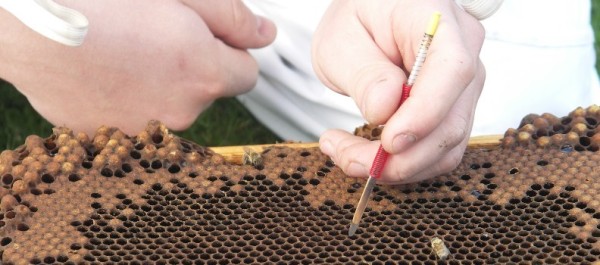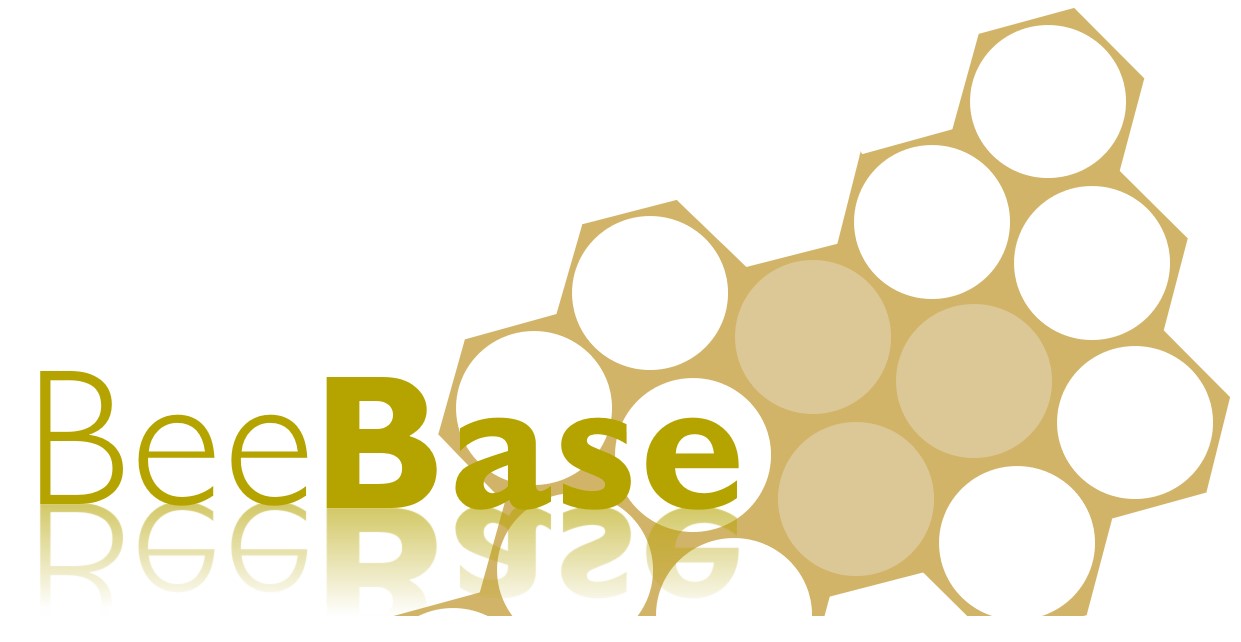Grafting
Eight to 24 hours after set-up, the graft frame is removed and young larvae are collected from a breeder colony, brushing the bees off the frames rather than shaking to avoid dislodging the larvae. Grafting has been successful whether done inside or outside, as long as the larvae are sheltered from direct sun and wind to prevent them from drying out. We often use a vehicle or building.
Worker larvae aged 12 to 18 hours from hatching are chosen for grafting. This ensures the larvae have the maximum time to be reared as queens and are also large enough to be grafted with reasonable acceptance rates. To obtain large numbers of larvae of the right age for grafting, empty brood combs can be added to a breeder colony, or a breeder queen caged overnight on an empty comb (i.e., using a queen excluder cage), four days prior to grafting.
Grafting is either done with a flexible ‘spatula-like’ tool, such as the Chinese grafting tool, or a solid metal tool, such as a dentist’s excavator. The Chinese grafting tool has the advantage of transferring a bed of royal jelly along with the larvae, but good acceptance rates have been obtained from dry grafting with a metal tool or a fine wetted paintbrush. Each larva is picked up by approaching from the outer convex curve of its ‘c’ shape. The completed grafts are returned to the rearing colony as soon as possible.
 Grafting using Chinese grating tool
Grafting using Chinese grating tool
Managing the Queen Cells
Checking Acceptance
Between one and three days after grafting, the graft frame is checked to assess cell acceptance. It is always handled gently without shaking or jarring but can be turned upside down to check the contents of the cells. Normally the bees have further extended the walls of accepted cells with beeswax, and each accepted larva is floating on a deep bed of royal jelly.
We have sometimes found that the first one or two batches of grafts of the year placed in a rearing colony have a poor acceptance, but then the batches to follow have a high acceptance rate. Occasionally however, a colony keeps giving poor graft acceptance rates, or destroys cells it has started. Possible reasons include the presence of a second queen located in the upper broodbox, or a damaged queen excluder allowing the queen to move through.
Destroying Emergency Cells
Sometimes the bees rear emergency cells on the brood frames in the upper brood box. Six or seven days after grafting, all combs of brood in the top brood box are shaken free of bees and any such queen cells destroyed. The removal of emergency queen cells can be performed at the same time as doing the brood rotation described later.
Removal of graft cells
The queen cells are left in the rearing colony for most of their development, as the mature queen pupae are then more robust and can be moved with less risk of damage. The queen cells are removed 11 days after grafting – about one day before the queens hatch. If consecutive batches are being grafted, the frames are marked to ensure the correct batch is removed. Queen cells are put into queen-less nucleus colonies as soon as possible after removal from the rearing colony. If there is going to be any delay, they are kept warm either by bees or in an incubator.
Brood Rotation
A queen rearing colony with sufficient numbers of nurse bees can rear further batches of grafts. Each rearing colony can normally easily rear one or two batches of 24 cells each week, continuously for several months. If further grafts are to be given to the rearing colony, it is re-arranged once a week by ‘rotating the brood’. Combs of recently sealed brood found below the queen excluder are moved to the upper brood box. Combs from which most or all the brood has emerged are moved down below the queen excluder for the queen to lay eggs in again. A frame of young brood is also moved up into position. Usually, one or two brood combs are rotated each week. The queen need not be found as the bees are shaken off the brood frames to be moved up. The time spent searching for brood frames to move up or down is minimised by adding them towards one end of the brood-box and removing them from the other. After two or three weeks a simple rotation pattern is established.
Using the Queen Cells
A day before the queen cells are due to hatch, they need to be used. Otherwise, there will be havoc created in the colony! There are a number of choices. The cells can be introduced to colonies, usually nucleus colonies (nucs), or they are often placed in specially designed boxes called mating nucs. Eleven days after grafting and one day before emergence we commonly introduce the queen cells to Apidea mating nucs.
